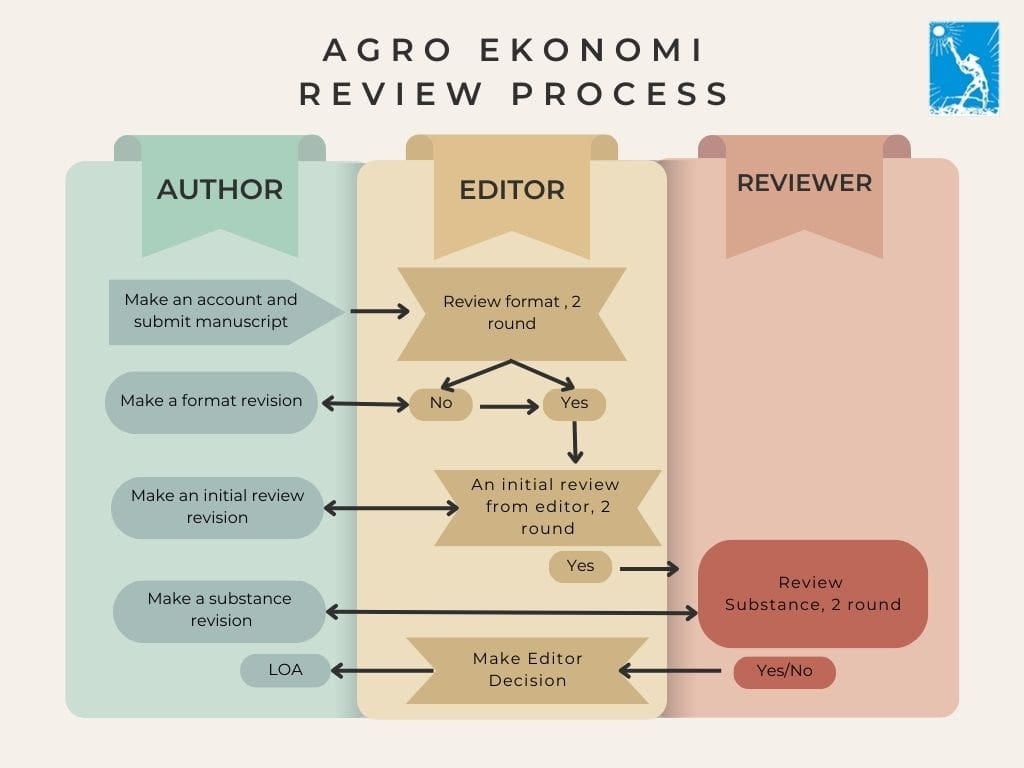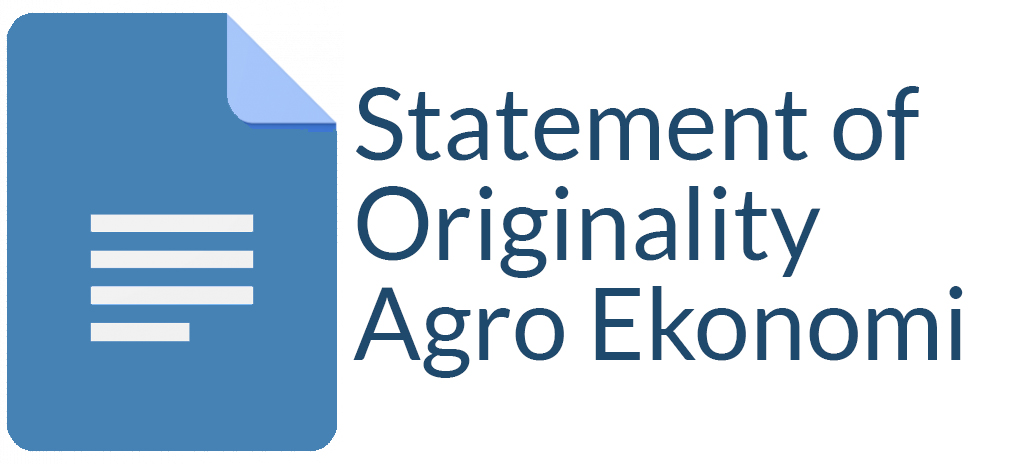How Risk Attitudes Affect the Implementation of Good Agricultural Practices in Sugarcane Farming
Annisa Fauzia Astari(1*), Irham Irham(2), Arini Wahyu Utami(3)
(1) Universitas Gadjah Mada
(2) Universitas Gadjah Mada
(3) Universitas Gadjah Mada
(*) Corresponding Author
Abstract
Indonesian Ministry of Agriculture issued Minister of Agriculture Regulations Number 53 in 2015 about Good Agricultural Practices for Sugarcane as an effort to increase production and productivity of sugarcane. The implementation of GAP on various commodities was differ since risk across commodities and risk attitude among farmers are varied. Hence, this study aims to analyze (1) the implementation level of Sugarcane GAP among farmers of the Wonolangan Sugar factory and (2) the influence of risk attitudes toward GAP implementation. The study was conducted on 102 randomly-selected farmers in Lumajang and Probolinggo Regency. The level of GAP implementation is measured by Likert scale with nine indicators of Sugarcane GAP. The level of GAP implementation is categorized into low, medium, and high based on the total score of GAP implementation obtained from each farmer. One-sample t-test is used to test the implementation level of GAP. Risk attitudes are measured with a Likert scale, as refers to Pennings and Garcia method. The influence of risk attitudes towards GAP implementation is analyzed using OLS regression. The result of t-test shows that the level of GAP implementation among sugarcane farmers is medium and high, and most farmers are risk-averse. Of the nine components used as indicators, seed preparation and labor welfare are in the medium category. Based on the OLS regression, risk-taker farmers have a lower GAP implementation than that of risk-averse farmers. Farmers' lack of knowledge about GAP guidelines, can be supported by the presence of socialization activities by sugar factories, extension workers, and related institutions.
Keywords
Full Text:
PDFReferences
Anggraini, A. (2018). Produktivitas Tebu Rakyat. In Irham, A. Nurhayati, M. Cholidi, & Daniyanto (Eds.), Peluang Peningkatan Produksi Gula dan Pendapatan Petani melalui Program Konsolidasi Pengelolaan Tebu Rakyat (pp. 67–68). Yogyakarta: Phoenix.
Asnah, Masyhuri, Mulyo, J. H., & Hartono, S. (2015). Tinjauan teoritis dan empiris efisiensi, risiko, dan perilaku risiko usaha tani serta implikasinya dalam upaya pencapaian swasembada pangan. Forum Penelitian Agro Ekonomi, 33(2), 81–94.
Ayinde, O. E. (2017). Risk Analysis in Innovation System: A Case - Study of Production of Vitamin A Ca. Journal of Agricultural Faculty of Gaziosmanpasa University, 34(3), 261–268. https://doi.org/10.13002/jafag4190
Bishu, K. G., O’Reilly, S., Lahiff, E., & Steiner, B. (2018). Cattle farmers’ perceptions of risk and risk management strategies: evidence from Northern Ethiopia. Journal of Risk Research, 21(5), 579–598.
Dadzie, S. K. N., & de-Graft Acquah, H. (2012). Attitudes Toward Risk and Coping Responses: The Case of Food Crop Farmers at Agona Duakwa in Agona East District of Ghana. International Journal of Agriculture and Forestry, 2(2), 29–37.
Domingo, S. N., Parton, K. A., Mullen, J., & Jones, R. (2015). Risk Aversion among Smallholder High-value Crop Farmers in the Southern Philippines. PIDS Discussion Paper Series, No. 2015-03, Philippine Institute for Development Studies (PIDS), Makati City.
Greiner, R., Patterson, L., & Miller, O. (2009). Motivations, risk perceptions and adoption of conservation practices by farmers. Agricultural Systems, 99, 86–104.
Hanafie, R. (2010). Pengantar Ekonomi Pertanian. Yogykarta: Andi.
Iqbal, M. A., Ping, Q., Abid, M., Kazmi, S. M. M., & Rizwan, M. (2016). Assessing risk perceptions and attitude among cotton farmers : A case of Punjab Province, Pakistan. International Journal of Disaster and Risk Reduction, 16, 68–74.
Kementan. (2015). Pedoman Budidaya Tebu Giling yang Baik. In Kementerian Pertanian. Jakarta.
Kibet, N., Obare, G. A., & Lagat, J. K. (2018). Risk attitude effects on Global-GAP certification decisions by smallholder French bean farmers in Kenya. Journal of Behavioral and Experimental Finance, 18, 18–29.
Kisaka-Lwayo, M., & Obi, A. (2012). Risk perceptions and management strategies by smallholder farmers in KwaZulu-Natal Province, South Africa. International Journal of Agricultural Management, 1(3), 28–39.
Mitra, S., & Sharmin, S. (2019). Risk Attitudes and Financial Profitability of Tomato Farmers - A Study in Bangladesh. Journal of Agricultural Sciences – Sri Lanka, 14(3), 207.
Nurhapsa, N., Arham, A., & Sirajuddin, S. N. (2018). Risk behavior of onion farmers in the District Enrekang. Sebelas Maret Business Review, 3(1), 1–7.
Sari, D. P., Syafruddin, R. F., & Kadir, M. (2016). Penerapan prinsip-prinsip Good Agricultural Practice (GAP) untuk pertanian berkelanjutan di Kecamatan Tinggi Moncong Kabupaten Gowa. Jurnal Galung Tropika, 5(3), 151–163.
Setiawan, F., Inonu, I., & Sitorus, R. (2015). Implementasi GAP (Good Agriculture Practice) lada dan pengaruhnya terhadap produktivitas lada di Desa Petaling Banjar, Kecamatan Mendo Barat. Enviagro, Jurnal Pertanian Dan Lingkungan, 8(2), 72–82.
Sriyadi, S., Istiyanti, E. I., & Risvansuna Fivintari, F. (2017). Evaluasi penerapan Standard Operating Procedure-Good Agriculture Practice (SOP-GAP) pada usahatani padi organik di Kabupaten Bantul. AGRARIS: Journal of Agribusiness and Rural Development Research, 1(2), 78–84.
Suharni, S., Waluyati, L. R., & Jamhari, J. (2017). The application of Good Agriculture Practices (GAP) of shallot in Bantul Regency. Jurnal Agro Ekonomi, 28(1), 48–63.
Suwanmaneepong, S., Kullachai, P., & Fakkhong, S. (2016). An Investigation of Factors Influencing the Implementation of GAP among Fruit Farmers in Rayong Province, Thailand. International Journal of Agricultural Technology, 12(7.2), 1745–1757.
Torres, M. A. O., Kallas, Z., & Herrera, S. I. O. (2019). Analysis of farmers’ stated risk using lotteries and their perceptions of climate change in the northwest of Mexico. Agronomy, 9(1).
Ullah, R., Shivakoti, G. P., & Ali, G. (2015). Factors effecting farmers’ risk attitude and risk perceptions: The case of Khyber Pakhtunkhwa, Pakistan. International Journal of Disaster Risk Reduction, 13, 151–157.
Wardani, A. N. T., & Darwanto, D. H. (2019). The Impact of GAP-SOP on The Production and Technical Efficiency of Garlic in Temanggung Regency. Agro Ekonomi, 29(2), 299.
Wauters, E., Winsen, F. van, Mey, Y. de, & Ludwig Lauwers. (2014). Risk perception , attitudes towards risk and risk management : evidence and implications. Agricultural Economics, 60(9), 389–405.
Wongprawmas, R., Canavari, M., & Waisarayutt, C. (2017). A multi-stakeholder perspective on the adoption of good agricultural practices in the Thai fresh produce. British Food Journal, 117(9), 2234–2249.Article Metrics
Refbacks
- There are currently no refbacks.
Copyright (c) 2018 Agro Ekonomi

This work is licensed under a Creative Commons Attribution-ShareAlike 4.0 International License.
Statcounter View My Stats












